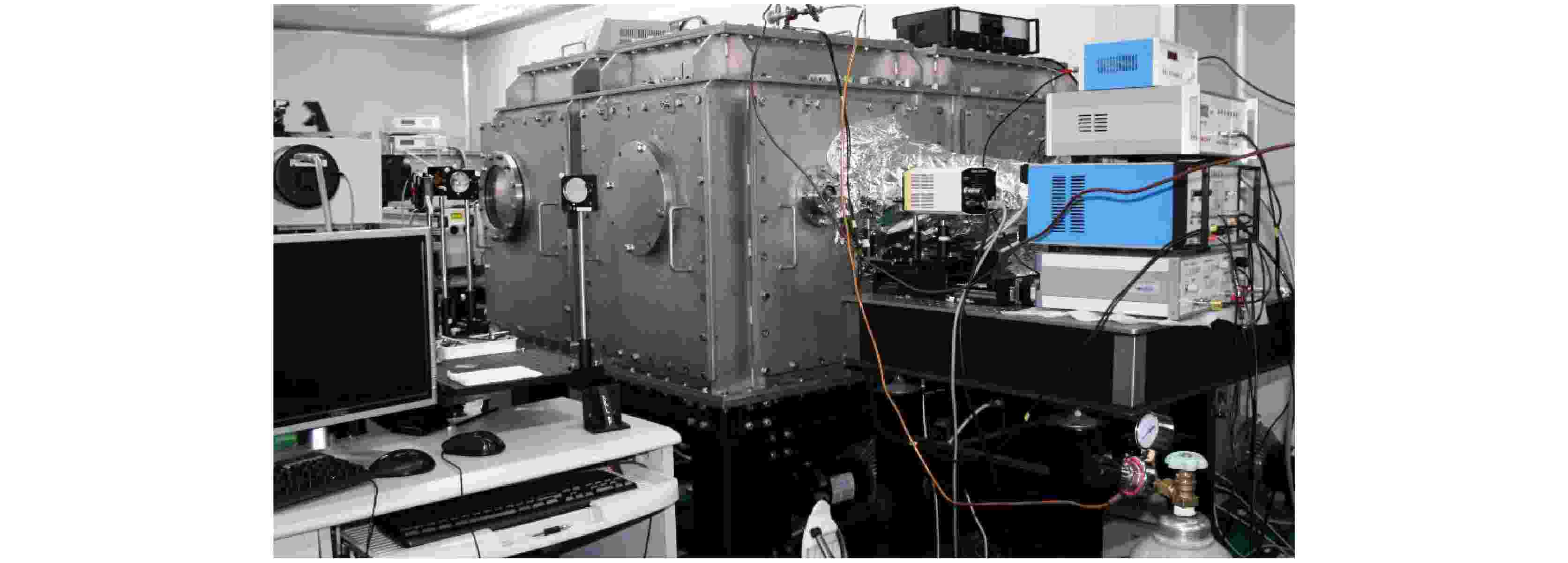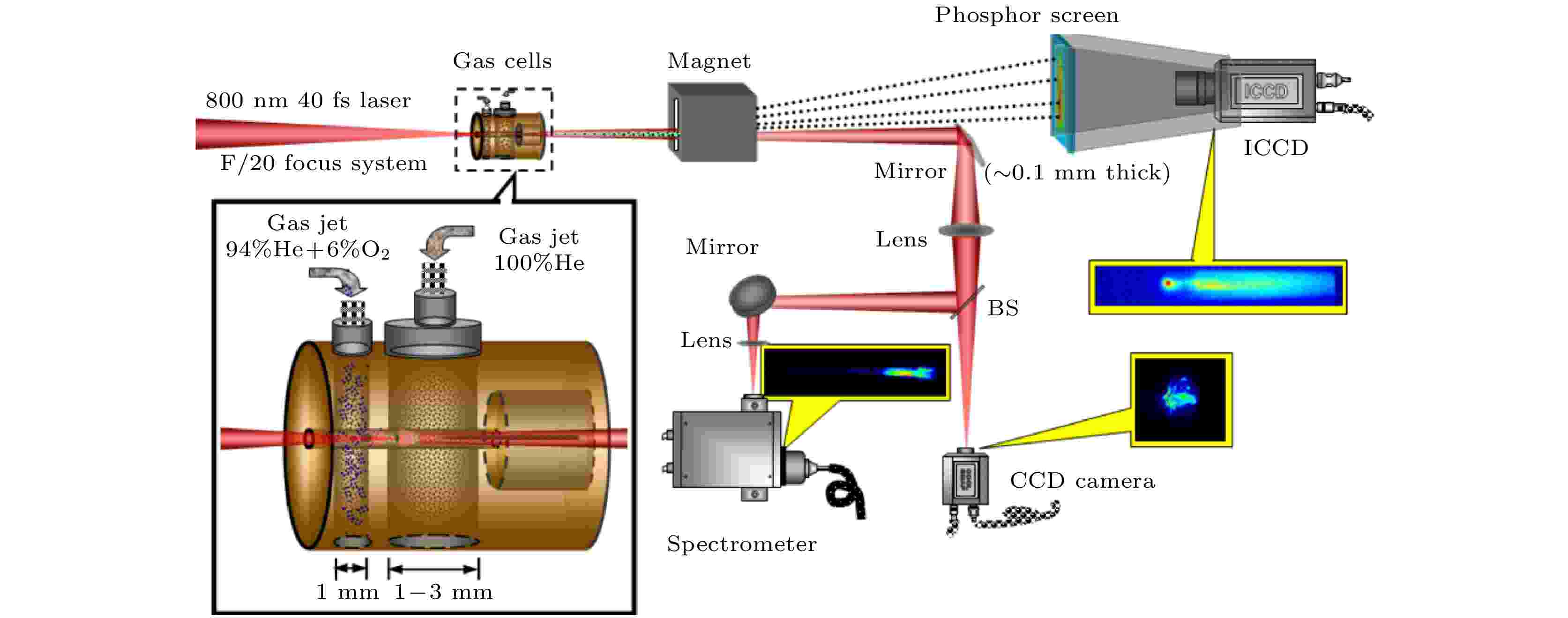全文HTML
--> --> -->LWFA对激光强度要求很高, 很长一段时间内, 受限于缺乏激发尾场的驱动源, 无法在实验上获得单能电子束. 1985年, 啁啾脉冲放大技术(CPA)的提出[2], 使得超强超短激光装置快速发展, 为激光尾波场的激发提供了相对论强度的驱动光源. 2004年, 来自英国、美国、法国的三个研究团队在实验上首次获得了百 MeV的准单能电子束, 相关研究成果也以“梦之束”为标题在《Nature》封面进行了报道[3-5], 标志着小型化粒子加速器的开端, 至此, 越来越多的研究团队投身于LWFA的研究中. 2006年, Leemans团队[6]进一步将电子束能量提高至GeV量级. 2007年Lu等[7]通过模拟优化了尾波场模型, 为激光尾波场电子加速提供了可靠的理论依据, 并提出如何利用单级尾波场加速获得数GeV能量的电子束. 2013年, 德克萨斯大学实验获得了2 GeV的电子束[8]. 在此以后, 激光尾波场电子加速能量的世界纪录一直被Leemans团队保持—2014年, 利用毛细管放电波导技术获得了峰值能量为4 GeV的电子束[9]; 2019年, 通过长20 cm的毛细管放电波导引导激光以保持良好聚焦, 得到了能量为8 GeV的电子束[10], 这也是目前国际上已经报道的基于LWFA电子的最高能量.
为实现LWFA的电子束的操纵与品质优化, 一系列新的注入机制与加速方案相继被提出. 中国科学院物理研究所在2006年提出了电离注入, 劳伦斯利弗莫尔国家实验室在实验上进一步验证并获得了约700 MeV的电子[11,12]. 德国马普所通过气体密度激波实现前端冲击注入, 实现了比自注入更稳定的注入, 获得了绝对能散较低的高品质电子束[13]. 上海交通大学、美国劳伦斯伯克利实验室(LBNL)、清华大学和北京大学等先后开展了基于双色激光驱动尾波场控制电子束性能的研究, 证明了这是一种可以产生低发射度或低能散的电子束的方法[14-17]. 不同于常规的单级加速, 中国科学院上海光学精密机械研究所和美国两个研究团队[18-20]在级联加速方面先后获得了突破. 级联加速方案的提出, 解决了难以平衡注入级和加速级等离子体密度的问题, 为高能量高品质电子束的产生奠定了基础. 随后, 许多相关研究团队在基于级联加速的方案上, 通过控制激光聚焦、等离子密度分布、电子注入方式等, 获得了更高品质的电子束. 韩国光州先进光子学研究所[21]基于级联加速的方式, 通过加速电子随着激光聚焦位置的改变在等离子体中获得引导, 得到了最高能量为3 GeV的电子束. 美国LBNL利用两束激光脉冲独立激发等离子体实现了多级加速, 并模拟证明了低密度等离子体条件下两极间耦合效率可趋近于100%[22]. 为了规避失相长度的限制, 解决激光无法在单级结构将电子能量推进到更高的问题, 罗彻斯特大学和巴黎理工学院先后提出了利用阶梯级反射实现时空耦合的无失相加速[23,24], 这种方案对激光器能量的需求较高.
除著名的超强超短激光实验室外, 许多传统的直线加速器实验室, 例如斯坦福直线加速器中心(SLAC)、法国应用光学实验室(LOA)、德国电子同步加速器研究所(DESY)等, 也都纷纷将目光投向了这一领域, 开始在该领域展开深入的实验研究, 加快了激光尾波场电子加速技术和应用技术的结合. 德国DESY在2020年, 连续获得十万发电子束, 为实现长时间稳定运行的激光等离子体加速器带来了曙光[25], 精确测量电子束能量漂移和抖动, 为电子束加速获得反馈与主动控制提供了依据.
经过国内外各研究团队持续的努力, LWFA在近十几年得到了飞速发展, 电子品质也逐步得到了完善. 然而受限于强场激光技术的发展、激光与等离子体相互作用的不稳定性、加速场的不均匀性等, 目前电子束品质, 无论是稳定性、能散度还是重频, 与传统射频加速器相比仍有一定差距. 要做到LWFA的稳定可用, 实现真正意义上的小型化加速“器”, 需要不断优化其性能来满足其在各种新型台式化辐射源中的应用需求.
利用搭建的平台, 如图1所示, 以理论、模拟和实验等多种方式进行LWFA的研究, 优化了焦斑分析方法和能谱分析参数的程序, 发展了电荷量标定方法, 实现对电量更为快速和精准的测量. 首先开展的是百太瓦激光与氢气喷流相互作用进行电子加速的实验研究, 分别研究了不同长度的气体喷流情况下激光加速电子. 增加气体喷流长度到1.5 mm时, 获得了电量约为2.6 nC, 截止能量为80 MeV的大电量电子束团. 通过诊断得知激光光谱展宽与电量存在相关性, 发现了注入和后向拉曼散射不稳定性之间的关联. 随后的实验进一步利用电离注入的方式, 以较低的激光强度获得了峰值能量为117 MeV的电子束. 通过注入方式、气体密度、激光强度等参数的改变, 逐步在实验中实现了一定范围内能量、能散、电量可调的电子束流.
 图 1 基于自制890 TW激光器建立的激光尾波场电子加速实验平台
图 1 基于自制890 TW激光器建立的激光尾波场电子加速实验平台Figure1. Laser wakefield electron acceleration experiment platform based on self-made 890 TW laser.
初期实验使用的等离子体密度都高于1019 cm–3, 获得的电子束具有能量低、能散度差和发散角大等缺陷. 根据Lu等[7,31]优化后的加速模型可以得出等离子密度过高会导致失相长度过短, 并且自聚焦会加剧激光泵浦损耗, 电子能量难以提升; 而当等离子体密度过低时, 电子则不容易发生注入. 为了解决这一矛盾, 2011年, 中国科学院上海光学精密机械研究所研究团队提出了将注入级和加速级分离的级联加速方案[20], 并通过实验证明了方案的可行性. 这一方案将气体池结构分为两部分(如图2所示), 第一部分注入高密度混合气体, 可实现电子的快速注入; 第二部分注入低密度纯氦气, 可获得较长的失相长度, 在小于1 cm激光自聚焦传输长度内实现对电子束更为高效的加速. 混合气体中H2和O2的掺杂比兼顾电子易于注入和避免激光泵浦能量的过多损耗. 同时为保证激光在加速级能够维持较好的自聚焦传输, 激光聚焦位置处于注入级和加速级中间. 实验证明了随着加速级长度的延长, 能量增益得到极大的提升. 级联的优点还体现在可以实现对注入级和加速器气体密度的独立控制, 通过调节和优化加速级气体密度和长度, 最终产生了能量0.8 GeV、能散25%、发散角2.6 mrad、电荷量为3.7 pC的准单能电子束, 如图3所示. 随后, 韩国先进光子学研究所也是利用该级联加速方案实现了2.3 GeV的能量突破[21].
 图 2 级联加速实验装置图[20]
图 2 级联加速实验装置图[20]Figure2. The experiment device of cascade acceleration[20].
 图 3 级联加速后的电子束能谱图[20]
图 3 级联加速后的电子束能谱图[20]Figure3. Electron beam energy spectrum based on cascade acceleration[20].
前期级联电子加速实验采用了电离注入, 电离注入主要通过俘获高原子序数气体的内层电子, 控制掺杂成分和掺杂比可以实现对电子注入电量和绝对能散的控制, 但同时由于注入时所需要的激光强度较低, 在激光导引过程中容易发生连续注入导致产生大能散电子束, 甚至是连续谱. 为有效解决电离注入造成的能散过大的问题, 需要发展一种在注入级实现较低绝对能散的方案来优化电子束能散. 2013年, 中国科学院上海光学精密机械研究所研究团队采用了基于梯度注入[32]的级联加速方案, 这是一种通过等离子体膨胀产生的密度梯度来控制电子注入的方式. 两段气体池均充入纯氦气, 密度梯度分布可由改变两个气体池的间距或者充入气体的密度差实现主动控制. 在实验中通过改变第二级等离子体密度使其刚好低于电子注入所需要的条件, 可以有效控制注入级的绝对能散. 随着加速级等离子体密度的进一步降低, 空泡尺寸会显著变大, 这样初始在注入级第二个空泡内的电子就将注入到加速级的第一个空泡周期内进行加速, 通过密度控制可以实现该团电子束被注入到加速级更为优化的相位, 最终被持续加速到0.5 GeV, 其能散度将显著下降到约3%, 如图4所示. 此外, 通过将加速级的长度增加并选择合适的等离子体密度, 获得了峰值能量为1.3 GeV的准单能电子束, 如图5所示.
 图 4 能散度3%电子束能谱图[32]
图 4 能散度3%电子束能谱图[32]Figure4. Electron beam energy spectrum with 3% energy spread[32].
 图 5 峰值能量>1 GeV能量电子能谱图[32]
图 5 峰值能量>1 GeV能量电子能谱图[32]Figure5. Electron beam energy spectrum with >1 GeV peak energy[32].
相比于单级加速机制, 级联加速机制不但在通过控制电子束注入过程优化电子束品质方面具有一定的优势, 还可以控制电子束注入到加速级的相位, 充分利用加速级获得更高能量的电子束. 同时也发现, 无论是基于电离注入还是梯度注入的级联电子加速实验中, 耦合效率均低于20%, 需要开展更多的研究工作来提高级联的耦合效率, 才可以将两级级联方案推进到多级级联.
中国科学院上海光学精密机械研究所自主研发的百TW级重频钛宝石激光装置, 利用多级啁啾脉冲放大技术, 实现了激光器200 TW, 1 Hz的稳定输出, 能量稳定度保持在0.65%以内[33], 高性能激光驱动源为进一步开展高品质激光尾波场电子加速器的研究提供了先决条件. 为进一步提高电子束品质, 中国科学院上海光学精密机械研究所于2016年提出了一种基于密度峰实现能量啁啾控制[34]以获得高品质电子束的实验方案. 实验采用级联加速方案, 通过上下两个喷嘴进行气体注入, 调节两个喷嘴的相对水平位置, 可以产生一个宽度约250 μm的高密度区. 利用形成的密度峰对电子束第二次自注入的抑制效应, 有效地实现了注入截止, 此外, 电子束在密度下降沿处会经过一段可实现能量啁啾负斜率尾场, 在束流尾部的低能电子获得较高的能量增益, 在头部的高能电子获得较低的能量增益. 通过调节等离子体密度分布, 最终获得能量为530—580 MeV, 能散小于1%, 平均发散角约为0.2 mrad的电子束, 结果如图6所示. 在这个工作中, 首次将传统加速器描述电子束流品质的六维相空间亮度引入, 用于表征激光尾波场电子加速束流品质. 实验最终获得的电子束六维相空间亮度[35]可达6.5—1015 A/(m2·0.1%), 如图7所示, 这是已报道的LWFA的5倍, 也首次接近了目前最先进直线加速器所获电子束亮度, 这种电子束流将有望实现台式化的自由电子激光.
 图 6 级联加速后的电子束角分辨能谱[34]
图 6 级联加速后的电子束角分辨能谱[34]Figure6. Angle resolved electron beams energy spectrum based on cascade acceleration[34].
 图 7 获得的高品质的电子束六维相空间亮度[34]
图 7 获得的高品质的电子束六维相空间亮度[34]Figure7. The six-dimensional phase space brightness of obtained electron beams[34].
同年, 该研究团队提出了利用电子束速度聚束(velocity bunching)效应来获得千分级超低能散高品质电子束的新方案[36]. 基于激光尾波场电子加速器, 该方案设计了三段等离子体区域, 分别为注入级、压缩级和加速级, 主要原理如下: 首先, 在注入级控制电子束注入, 电子束在注入过程中由于前端电子更早被捕获而被加速到更高能量, 注入结束时电子束为能量负啁啾分布; 然后, 完成注入的电子束传输进入压缩级, 由于电子束所处加速场存在前后梯度差, 在电子束Beam Loading效应不显著的情况下, 电子束会发生相空间旋转, 导致其能量啁啾转变为正啁啾分布, 即电子束尾部电子能量更高, 随着电子束的传输, 电子束长度会被压缩甚至发生前后电子位置交换; 最后, 通过控制压缩级长度, 将长度被压缩且能量啁啾重新演化为负啁啾的电子束传输进入加速级, 由于电子束长度获得极大压缩, 电子束会在更高的能量状态下达到能量啁啾补偿点, 从而得到超低相对能散电子束的输出. 采用一维理论推导和二维PIC(particle-in-cell)模拟证明了该方案的可行性, 并在模拟中获得了能量为784 MeV, 电荷量为4.5 pC, 能散为0.2%的超低能散高品质电子束输出.
通过控制电子在尾波场中的注入过程可以有效提升注入时电子束的品质, 例如可以压缩绝对能散、提升电量或者降低发射度等, 这对于优化最终获得的电子束的品质是尤为重要的. 2018年, 中国科学院上海光学精密机械研究所设计了一种U型尖峰结构, 产生了一种更尖锐的气体密度“激波”, 可以更有效地压缩电子注入的绝对能散[37]. 通过调整气体喷嘴和U型尖峰结构的相对位置, 超音速气流会产生局部高密度区, 如图8所示. 三维模拟证明, 该结构有利于将电子束加速到更高能量, 并具有更低的能散. 此外, 通过调节激波角度可实现对电子束电量和能量的主动控制.
 图 8 U型尖峰结构形成等离子体分布模拟图[37]
图 8 U型尖峰结构形成等离子体分布模拟图[37]Figure8. Simulation of plasma distribution formed by U-shaped spike structure[37].
为了提升高性能电子束的稳定性和重频, 实现稳定可用的激光尾波场电子加速器, 中国科学院上海光学精密机械研究所对CPA激光驱动源各项输出指标进行了优化. 2018年, 中国科学院上海光学精密机械研究所采用实验室温控小于 ± 0.3 ℃、利用自准直反馈等技术手段, 有效提升激光器种子激光脉冲光束指向稳定性到小于1.5 μrad, 并改进功率放大器, 使激光器在200 TW, 1 Hz的条件下, 实现连续90 min能量抖动小于0.55%的稳定输出[38]. 激光器重频、高稳定性的脉冲输出, 对于激光尾波场电子加速器的研制过程极为重要, 它可以有效确保电子输出的重复性, 并可进一步实现对电子束流性能的优化. 利用优化的激光器, 通过调节等离子体密度分布同激光参数匹配, 寻找连续稳定产生高品质电子束流的实验条件并获得了能量为680 MeV, 稳定性为3%, 峰值流强为10 kA的电子束(连续采集300发次), 电子能谱图如图9所示. 高稳定性有利于电子束品质的精度优化, 高品质的、具有一定重频的电子束, 对于实现电子长距离聚焦传输研制台式化自由电子激光具有重要意义.
 图 9 连续300发电子加速峰值能量分布及部分能谱图
图 9 连续300发电子加速峰值能量分布及部分能谱图Figure9. Accelerated peak energy distribution of 300 consecutive electrons and part of energy spectrum.
通过诊断实时监测激光和等离子体相互作用过程获得参数反馈, 是加速电子从产生到实现主动控制以获得更高品质的必要条件. 中国科学院上海光学精密机械研究所研究团队采用多种诊断方式, 以确保实验量化可控. 除了激光输出参数的实时监测外, 对电子加速的诊断主要包括等离子体通道诊断、电子束流诊断和辐射测量三个方面. 等离子通道诊断包括等离子体密度、等离子体区域长度、磁场测量等, 束流诊断包括电子束能量、能散、尺寸、电量、发射度、脉宽等表征参数; 辐射测量主要通过测量相互作用过程中的伴生辐射, 例如Betatron辐射、谐波等, 实现对相互作用过程的反演. 多种测量手段, 除了优化电子束流品质外, 还可以通过模拟和构建模型对相互作用过程进行反演. 在激光尾波场电子注入过程监测中, 在通过迈克尔孙干涉仪测量等离子体密度的基础上, 利用法拉第磁光偏转效应搭建了具有时间分辨能力的激光探针, 可以单发探测来自不同位置的电子束团, 同时实现电子束团在注入级和加速级的监测. 对激光在低密度等离子体导引中的多丝过程进行观察, 证明多丝过程同时会激发多个等离子体尾波对电子进行加速, 相比于单丝的情况, 激光多丝化后加速的电子品质较差[39], 应该优化激光的聚焦质量, 尽量避免这一过程. 在电子束参数测量方面, 除了借鉴传统加速器中普遍采用的能谱仪、ICT、电子束流剖面分析仪并加以改进外, 中国科学院上海光学精密机械研究所团队利用测量Betatron辐射实时测量电子束横向发射度[40]. 通过二维PIC模拟, 获得了和实验测量一致的结果, 证明了用测量Betatron辐射计算电子束横向发射度方案的可行性.
目前基于激光尾波场加速的电子在性能和重复频率等方面还不足以满足应用需求, 仍需要更多的理论和实验技术方面的研究, 包括新注入机制探索、空泡结构的高分辨测量、超长低密度等离子通道研制、机器学习辅助电子束性能优化等. 本文对所在团队近年研究进行归纳与总结, 旨在对激光尾波场电子加速的研究有更完备和清晰的认识, 也希望能促进交叉学科领域的合作和交流.
